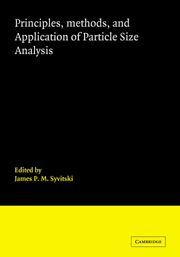II - Theory and methods
Published online by Cambridge University Press: 28 January 2010
Summary
There have been many techniques developed for the size characterization of geological samples. The earliest was the Oden balance (Oden, 1915), which utilized tangents to the Oden curve (weight of accumulated sediment vs. settling velocity). Some were developed for specific purposes: For instance, the falling-drop method (Mourn, 1965) and the volume size analysis (VSA – Syvitski & Swinbanks, 1980) were separately developed for the analysis of small volumes of mud samples. Many of the early techniques have been superseded by faster and more precise automated instruments. In Part II we describe the principal techniques used in modern geological particle size analysis.
Settling tubes provide an ever-popular means for the size characterization of sands and coarse silt samples. Results are in the form of particle settling velocity or sedimentation diameter. Both are considered more fundamental than other geometrically defined measures of size, with reference to a particle's behaviour in the hydrodynamic environment. Chapter 4 documents the complexities and varieties of settling columns, including an analysis of errors, the principles of tube calibration, and a simplified description on how to construct a settling tube.
Sieving of sand is a classical size technique, being at least 50 years old. Since those early days, the variety of sieves in use has increased, including sieves constructed of plastics, brass, and stainless steel. Some are particularly useful for wet sieving of biological matter. Chapter 5 documents the more classical methodology of dry sieving and calibration of wirecloth sieves, but with particular reference to small sieves useful in the analysis of small sample weights.
Information
- Type
- Chapter
- Information
- Publisher: Cambridge University PressPrint publication year: 1991
